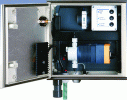

The quality of water standards is constantly on the increase and as a result, monitoring stages are being tested more and more by on-line measuring devices, which allow for a greater frequency of analysis than is possible with quality monitoring by lab analysis. The potential long time delay posed by lab analysis has been a major obstacle for accurate, good quality results. Endress+Hauser offers a range of robust on-line analysers as well as a comprehensive range of sample preparation systems, to provide complete measuring points for a very wide spectrum of applications.
The high frequency of analysis that results from automatically determining measured values offers a host of advantages. Up-to-date information on the process status at any time is available and rapid timely reaction to changes or faults in the process status is now possible. In addition, there is complete proof of product properties within the framework of quality assurance, and it is possible to optimise the process. Savings can be made on raw materials due to tighter quality control and closer observation of product specification, and energy savings are realised. Finally, there is less pollution, thanks to a reduction in contaminants.
"These advantages apply wherever automatic measuring devices are used, and we at Endress+Hauser provide suitable devices for various applications and parameters. However, a good analyser alone does not return a measurement result that can be used. The right sampling point, as well as correct sample conditioning, are key factors in ensuring accurate measurement - again, Endress+Hauser offers a range of solutions," states Jacques Fouche, product manager: analysis, Endress+Hauser.
Analytical measuring devices need to make it possible to continuously monitor operating values. It is therefore essential that the sampling point and sampling unit are selected in such a way that the user obtains a value that represents the process. If this is not taken into account, the values cannot be used. Values to be monitored must also be available in time. What 'in time' actually means must be specified, as it will differ for each individual case.
The condition of the sample also plays a key role when utilising on-line measuring technology. Most analysis units require a particle free sample to prevent the device from clogging. In the case of analysers with photometric measurement, solids have an effect on the measurement result. Conditions in sewage treatment plants have changed over time, and users have had to consider these new requirements and implement practical solutions. Sedimentation, the cheaper alternative, which had been propagated in the past few years, can generally no longer be used, because the settling behaviour - which is the basic prerequisite for sedimentation - has altered, and in many treatment plants, sedimentation no longer takes place in time.
"Since not every method of sample conditioning can be used at every sampling location, Endress+Hauser offers a variety of systems for sample conditioning. To this end, conventional ultra-filtration as well as plate sample filtration CAT430, micro-filtration and a backwash filter are available," Fouche explains. Up to a short time ago, ultra-filtration and sedimentation were seen as the only methods of sample conditioning it made sense to use them. The limits of sedimentation have already been explained and ultra-filtration is not a cost-effective solution. As a result, the plate filter is increasingly becoming the cheaper and sensible alternative for sample conditioning.
Endress+Hauser's plate filter - CAT430 is a system that can be used for all Endress+Hauser analysers. In contrast to conventional ultra-filtration units, CAT430 transports clear/filtered samples from the activated sludge basin to the measuring devices. It is no longer necessary to transport wastewater. Advantages of the plate filter include ease of maintenance, a lower investment cost and reduced operating costs.
With regard to analysers, all Endress+Hauser analysers work along the photometric measuring principle. Since the majority of the parameters to be measured are based on colourless substances, the samples need to be 'dyed'. This is done chemically using specific reagents that react with the particular substance to form a colour. Other substances present in the water remain colourless. The intensity of the colour is an indicator for the level of concentration of the substance being investigated. The coloured sample is then passed through light and the light intensity after passing through the sample is measured. The reduction in light intensity does not however take place across the entire wavelength spectrum, but is restricted to specific wavelengths. The measurement result can be read off directly from the display and is available as a current output signal and two limit contacts.
According to Fouche, "Our analysers are not only used in sewerage treatment plants, but can also be used in industrial processes or in applications where wastewater is conditioned for drinking water." An example of this is the removal of iron and manganese from drinking water. By measuring iron with Endress+Hauser's CA71FE or continuously determining manganese with CA71MN, filter backwash times, the use of flocculants and the aeration cycles for manganese removal can be optimised. These devices measure extremely accurately in the µg/1 range and are very sparing in the use of reagents and wear parts.
"With the analysers for various parameters, Endress+Hauser is completing its offering as a complete provider for measurement in various water circuits, providing both systems solutions and complete measuring containers. In the future, more and more processes will be monitored with automatic analysers. The demands made on measuring technology will shift more to the trance range and clients' demands for reduced reagent consumption will influence future developments," says Fouche. The picture shows CA71AL - a photometric analysis system for the aluminium measurement in drinking water and wastewater.
For more information contact Jacques Fouche, Endress + Hauser, 011 262 8000, [email protected]
| Tel: | +27 11 262 8000 |
| Email: | [email protected] |
| www: | www.endress.com |
| Articles: | More information and articles about Endress+Hauser South Africa |

© Technews Publishing (Pty) Ltd | All Rights Reserved